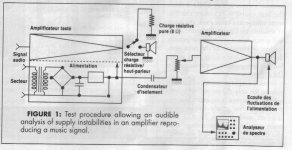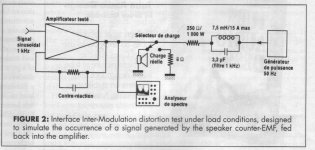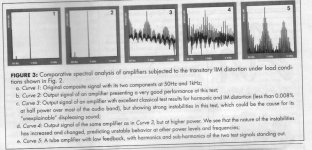In AudioExpress May 2005, there is an article by Jean Hiraga translated by Jan Didden " The Many Faces of Distortion". I thank Janneman for this.
There is one point that makes me very curious. What amp (Brand/Model) that performs the measurement of curve 2 in figure 3 (in page 45)? Is it imaginary amp, or real amp?
There is one point that makes me very curious. What amp (Brand/Model) that performs the measurement of curve 2 in figure 3 (in page 45)? Is it imaginary amp, or real amp?
Hi, Anli,
I got the article from Janneman. I really should ask Janneman first, cause the magazine is new.
Janneman, how is this?
I got the article from Janneman. I really should ask Janneman first, cause the magazine is new.
Janneman, how is this?
This is the second experiment. He intentionally feed the output of the amp (which is attached to dummy load or speaker) with outside signal.
The amp is having feedback. The signal injector on right consist of very big 250ohm (1000W), very big inductor (7.5mH, 15A)
The result, feedback system doesn't know which is music signal and which is outside signal. It processes both, resulting IM.
The amp is having feedback. The signal injector on right consist of very big 250ohm (1000W), very big inductor (7.5mH, 15A)
The result, feedback system doesn't know which is music signal and which is outside signal. It processes both, resulting IM.
Attachments
This is the result of experiment 2.
Fig 1 is the original 1khz signal and 50hz injected signal.
Fig 2-5 is output of various amps.
Fig 5 is from good tube amp with low feedback. Not as clean as 2, but the listener enjoys the sound.
Fig 3-4 is from ordinary amp with 0.008THD, but somehow the sound is not OK.
It is fig2 that raise my question. What amp (brand/model) can give such a clean reproduction?
Fig 1 is the original 1khz signal and 50hz injected signal.
Fig 2-5 is output of various amps.
Fig 5 is from good tube amp with low feedback. Not as clean as 2, but the listener enjoys the sound.
Fig 3-4 is from ordinary amp with 0.008THD, but somehow the sound is not OK.
It is fig2 that raise my question. What amp (brand/model) can give such a clean reproduction?
Attachments
lumanauw said:This is the result of experiment 2.
[...]
It is fig2 that raise my question. What amp (brand/model) can give such a clean reproduction?
That's my question too! Not so much brand and model, but rather, what is its topology? What are the technical reasons behind this? Where's the math that explains it, allowing others to make use of the results? And why did he omit this key information? The commentary of the picture says "Output signal of an amplifier presenting a very good performance in this test." Well, no **** Sherlock!
I suppose if he had actually provided this information, he would have had some real explaining to do. Especially if it was a feedback amplifier.
Probably, it is balanced class A: there is constant power consumption at such case. Eliminating most of PS problems - this is the reason I'm DIY-ing such topology amplifier just now 🙂
I suspect that his dog is a beagle that weighs between 7 and 13 pounds, is mostly black in color, and eats Kal-Kan twice a day, except when the neighbor dog is in heat.
But seriously though, we really can't reach any conclusions based on the information given. In fact, there was no information given at all regarding the nature of this amplifier. Do you suppose this was an accident? Is it easier to say "This is amplifier X" or to say "This is the amplifier that did well in this test"?
Seems like just another case in audio where the extent to which an assertion is accepted as fact is inversely proportional to how rigorously that assertion is justified.
"Barrie Gilbert says so..."
"What? If you actually read and understood what Gilbert was saying, you'd realize..."
"I don't care what Barrie Gilbert says, the end result is sonically..."
and on and on.
But seriously though, we really can't reach any conclusions based on the information given. In fact, there was no information given at all regarding the nature of this amplifier. Do you suppose this was an accident? Is it easier to say "This is amplifier X" or to say "This is the amplifier that did well in this test"?
Seems like just another case in audio where the extent to which an assertion is accepted as fact is inversely proportional to how rigorously that assertion is justified.
"Barrie Gilbert says so..."
"What? If you actually read and understood what Gilbert was saying, you'd realize..."
"I don't care what Barrie Gilbert says, the end result is sonically..."
and on and on.
The question is whether there was the PSRR mentioned and its frequency characteristics shown. This is the key factor to assess the PSU influence on amplifier's sound.
lumanauw said:According to Jean Hiraga, every aspect is important in power amps, including the power supply.
This is one of Jean Hiraga experiment. He "listens" to power supply.
David,
I send you the magazine as I had an extra copy. I translated this magazine for AX, and I got some goodies from them for it. So as far as I am concerned it is their copyright/property.
Also please note that the original author was yet another gentleman, Jean Hiraga, who certainly 'owns' it because he has done all the work to measure, interprete and write. I find it wrong to give out electronic copies of this; if it would happen to an article of mine, I would really be pissed!
If all of you find this so usefull, why not buy the back-issue? How would you feel if your friend would continuously and constantly take advantage of you without anything in return? How long would he remain your friend?
Jan Didden
anli said:Probably, it is balanced class A: there is constant power consumption at such case. Eliminating most of PS problems - this is the reason I'm DIY-ing such topology amplifier just now 🙂
... pure speculation, of course...
Jan Didden
andy_c said:I suspect that his dog is a beagle that weighs between 7 and 13 pounds, is mostly black in color, and eats Kal-Kan twice a day, except when the neighbor dog is in heat.
But seriously though, we really can't reach any conclusions based on the information given. In fact, there was no information given at all regarding the nature of this amplifier. Do you suppose this was an accident? Is it easier to say "This is amplifier X" or to say "This is the amplifier that did well in this test"?
Seems like just another case in audio where the extent to which an assertion is accepted as fact is inversely proportional to how rigorously that assertion is justified.
"Barrie Gilbert says so..."
"What? If you actually read and understood what Gilbert was saying, you'd realize..."
"I don't care what Barrie Gilbert says, the end result is sonically..."
and on and on.
Andy,
My take on this, knowing Jean as an honest person, is that the information is genuine, but that he deliberately omitted brand/type information to avoid losing yet another of his precious advertisers.....
Jan Didden
Jan,
I see, uderstand and share your point of view absolutely.
Unfortunately, it is impossible to by _any_ audio-related magazine/book/so-on here, in russian province. Free distributed (or privately sent under some conditions) articles copies is the only way to get some new info :-(
Andrew
I see, uderstand and share your point of view absolutely.
Unfortunately, it is impossible to by _any_ audio-related magazine/book/so-on here, in russian province. Free distributed (or privately sent under some conditions) articles copies is the only way to get some new info :-(
Andrew
I have an admiration trespassed for the original approach that Hiraga has toward the audio amplification. Some of my ideas even are born from the study of her point of view, even if succeed to read very little articles his ( this not the have read ).
When the problem is lifted to show " scientifically " the quality of the amplifiers instigates always an ample polemic, but perhaps it is to the base of the "science" have many theories.
To answer to lumanauw, I wish I were there too remember that not neccessary the amplifier of fig. 3 curve 2 is what rings better, but simply it's the more immune from the MFB. Remember that " normally " the human ear prefers the conditions of Fig.3 curve 5.
In connection with the "sound" of the PSU, have a lot of "fine distinction" from behaviour ( es. common mode conditions etc...) for which that type of "investigation" go taken ( in accordance with me ) as a definitive test on the quality of the PSU, but not having bed the article, not am not able take position in clean way. Surely Hiraga has take the necessary steps by himself to explain the reasons ( and the limits ) of his test. For what concerns the "dungeon" topology of Fig. 3 curve 2 , there are about tens of the opportunity to oppose the MFB the problem is establish if is useful to do it or no.
Ciao
Mauro
When the problem is lifted to show " scientifically " the quality of the amplifiers instigates always an ample polemic, but perhaps it is to the base of the "science" have many theories.
To answer to lumanauw, I wish I were there too remember that not neccessary the amplifier of fig. 3 curve 2 is what rings better, but simply it's the more immune from the MFB. Remember that " normally " the human ear prefers the conditions of Fig.3 curve 5.
In connection with the "sound" of the PSU, have a lot of "fine distinction" from behaviour ( es. common mode conditions etc...) for which that type of "investigation" go taken ( in accordance with me ) as a definitive test on the quality of the PSU, but not having bed the article, not am not able take position in clean way. Surely Hiraga has take the necessary steps by himself to explain the reasons ( and the limits ) of his test. For what concerns the "dungeon" topology of Fig. 3 curve 2 , there are about tens of the opportunity to oppose the MFB the problem is establish if is useful to do it or no.
Ciao
Mauro
David,
I send you the magazine as I had an extra copy. I translated this magazine for AX, and I got some goodies from them for it. So as far as I am concerned it is their copyright/property.
Also please note that the original author was yet another gentleman, Jean Hiraga, who certainly 'owns' it because he has done all the work to measure, interprete and write. I find it wrong to give out electronic copies of this; if it would happen to an article of mine, I would really be ****ed!
If all of you find this so usefull, why not buy the back-issue? How would you feel if your friend would continuously and constantly take advantage of you without anything in return? How long would he remain your friend?
Jan Didden
Yes, I understand it very well. And up until now I haven't give any scan of it to anyone (Anli, sorry about this), cause I know this (your above comment) will happened.
But I think attaching the (part of ) pictures is OK for discussion here. Is it OK with you?
I feel "not good". Am I still your friend?
Probably, it is balanced class A
Or regulated psu and zero global NFB ?
I feel it is quite imposible to get curve2. Even local feedback (RE degeneration only) will give messier result. More impossible with feedback.
Another clue. Jean Hiraga stated that all amps have different ratings. Is it possible to get curve2 with very low wattage?
Reading this article will give very good information (Please buy the magazine).
This article interest me because he explain audio understandable. He wrote an experiment about how n'th harmonic becomes audible. Base tone=400hz 76dB. 2nd harmonics needs quite loud level (from the basic tone) to be heard (61dB). 3rd (58dB), 4th (50dB),.... needs less and less level tobe noticed. Harmonics in orde or 15-20 needs only 0.008% of the total sound energy tobe noticed. This explains how higher harmonics (which is not good sounding) are noticeable even in very very low level.
Light vs sound
If we spot blue light with green light we can see yellow light only without able to see the original green and blue. Mix all the light in rainbow will produce white light.
Not so with sound. In piano, you push "do" and "sol" at the same time, you will not hear 1 blended sound, but you will hear 2 tones together. You listen to white noise (blend of all tones), you will not hear 1 blended tone, but you can hear it is a mix of many tones. This is important base, that our ear will able to hear even slightest "dissonant" tone in a full reproduction. Not so noticealbe, but our brain will process the whole sound as "not pleasant".
More sections about typical distortion curves of power amps. About IIM (Matti Otala). About importance of power supply, etc.
Back to the question. Has anyone have seen topology that can give curve2?
I have tried to reproduce the test of fig. 2 but doesn't succeed to reproduce the conditions of fig. 3 curve 3-5-5.
All the amplifiers that connect involve as in fig. 2! observing the curve 3-4-5 the type of modulation is typical of an saturation (clipping) and not in linear conditions.
In curve 2 notice of the "side band" on the 50 Hz rather than to the 1Khz sides (+-50hz ) as is correct to await in case of intermodulation. Question: some that is able to reproduce and interpret this graph?
ciao
Mauro
All the amplifiers that connect involve as in fig. 2! observing the curve 3-4-5 the type of modulation is typical of an saturation (clipping) and not in linear conditions.
In curve 2 notice of the "side band" on the 50 Hz rather than to the 1Khz sides (+-50hz ) as is correct to await in case of intermodulation. Question: some that is able to reproduce and interpret this graph?
ciao
Mauro
- Status
- Not open for further replies.
- Home
- Amplifiers
- Solid State
- The many faces of distortion


